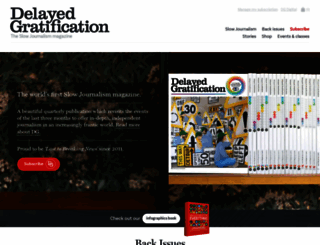Delayed Gratification | The Slow Journalism Magazine | Last to breaking news
Page Load Speed
3.9 sec in total
First Response
530 ms
Resources Loaded
2.7 sec
Page Rendered
682 ms

About Website
Visit slow-journalism.com now to see the best up-to-date Slow Journalism content for United States and also check out these interesting facts you probably never knew about slow-journalism.com
Delayed Gratification is the world's first Slow Journalism magazine, a beautiful quarterly publication which is proud to be 'Last to Breaking News'.
Visit slow-journalism.comKey Findings
We analyzed Slow-journalism.com page load time and found that the first response time was 530 ms and then it took 3.4 sec to load all DOM resources and completely render a web page. This is a poor result, as 60% of websites can load faster.